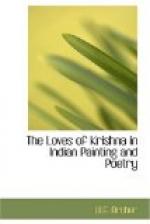Although the actual date of the Mahabharata war has been variously assessed—’between 1400 and 1000 B.C.’ (M.A. Mehendale in The Age of Imperial Unity, 251) ’the beginning of the ninth century B.C. (Basham, op. cit., 39)—the epic itself is generally recognized as being a product of many centuries of compilation. The portions relating to Krishna the hero may well date from the third century B.C. The Gita, on the other hand, was possibly composed in the second century B.C. ’but assumed the form in which it appears in the Mahabharata today in the early centuries A.D.’ (Mehendale, op. cit., 249).
Note 5, p. 24.
The implication is that the Pandavas have not been granted ultimate salvation i.e. final release from living but have reached the important transitional level of ‘the heaven of the doers of good deeds.’ They have also been granted the limited status of petty gods.
Note 6, p. 25.
Harivansa, ‘the Genealogy of Krishna’ but more literally, ’the Genealogy of Hari,’ a synonym for Vishnu. For the sake of clearness and to avoid burdening the text with too much periphrasis, I have throughout referred to Krishna as such. In the texts themselves, however, he is constantly invoked under other names—Hari (or Vishnu), Govinda (the cowherd), Keshava (the hairy or radiant one), Janarddana (the most worshipful), Damodara (’bound with a rope,’ referring to the incident (p. 32) when having been tied by Yasoda to a mortar, Krishna uproots the two trees), Murari (’foe of Mura, the arch demon’ p. 58) or in phrases such as ‘queller of Kaliya the snake,’ ‘destroyer of Kesi, the demon horse,’ ’slayer of Madhu—the demon who sprang from the ear of Vishnu and was killed by him.’ A similar use of periphrasis occurs in Anglo-Saxon kennings (’world-candle’ for sun, ‘battle-adders’ for arrows). In the same way, Abul Fazl’s chronicle, the Akbarnama, never names the emperor Akbar but refers to him in terms such as ‘His Majesty,’ ‘the holy soul,’ ’lord of the age,’ ‘fountain of generosity,’ ‘the sacred heart,’ ’the world-adorning mind,’ ‘the decorated mansion of sports.’
Note 7, p. 26, 34, 46, 68, 69.
In Chapters 3 and 4 I have, in the main, strictly followed the Bhagavata Purana, incorporating, however, a few important details and passages either not given in this text but included in the Vishnu Purana or if given, not so vividly expressed. The details and passages in question are page 27 concerning the white and black hairs of Vishnu, page 34—the lyrical description of Krishna’s life in the forest, page 46—Akrura’s meditation as he goes to visit Krishna, page 68—the drunken brawl and page 69 the deaths of Balarama and Krishna. All extracts are from H.H. Wilson, The Vishnu Purana (pages 498, 511, 541-2, 609-612).
Note 8, p. 28.
The resemblance between Kansa’s order to kill all male infants and Herod’s slaughter of the innocents has often been remarked.




